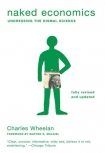Naked Economics, Wheelan, Charles [open ebook .txt] 📗

Book online «Naked Economics, Wheelan, Charles [open ebook .txt] 📗». Author Wheelan, Charles
CHAPTER 7
Financial Markets:
What economics can tell us about getting rich quick (and losing weight, too!)
W hen I was an undergraduate many years ago, a new diet swept through one of the sororities on campus. This was no ordinary diet; it was the grapefruit and ice cream diet. The premise, as the name would suggest, was that one could lose weight by eating large amounts of grapefruit and ice cream. The diet did not work, of course, but the incident has always stuck with me. I was fascinated that a very smart group of women had tossed aside common sense to embrace a diet that could not possibly work. No medical or dietary information suggested that eating grapefruit and ice cream would cause weight loss. Still, it was an appealing thought. Who wouldn’t want to lose weight by eating ice cream?
I was reminded of the grapefruit and ice cream diet recently when one of my neighbors began to share his investment strategy. He had taken a big hit over the past year because his portfolio was laden with Internet and tech stocks, he explained, but he was plunging back into the market with a new and improved strategy. He was studying the charts of past market movements for shapes that would signal where the market was going next. I cannot remember the specific shapes he was looking for. I was distracted at the time, both because I was watering flowers and because my mind was screaming, “Grapefruit and ice cream!” My smart neighbor, who is both a doctor and a university faculty member, was venturing far from the halls of science with his investment strategy, and that is the broader lesson. When it comes to personal finance (and losing weight), intelligent people will toss good sense aside faster than you can say “miracle diet.” The rules for investing successfully are strikingly simple, but they require discipline and short-term sacrifice. The payoff is a slow, steady accumulation of wealth (with plenty of setbacks along the way) rather than a quick windfall. So, faced with the prospect of giving up consumption in the present for plodding success in the future, we eagerly embrace faster, easier methods—and are then shocked when they don’t work.
This chapter is not a primer on personal finance. There are some excellent books on investment strategies. Burton Malkiel, who was kind enough to write the foreword for this book, has written one of the best: A Random Walk Down Wall Street. Rather, this chapter is about what a basic understanding of markets—the ideas covered in the first two chapters—can tell us about personal investing. Any investment strategy must obey the basic laws of economics, just as any diet is constrained by the realities of chemistry, biology, and physics. To borrow the title of Wally Lamb’s best-selling novel: I know this much is true.
At first glance, the financial markets are remarkably complex. Stocks and bonds are complicated enough, but then there are options, futures, options on futures, interest rate swaps, government “strips,” and the now infamous credit default swaps. At the Chicago Mercantile Exchange, it is now possible to buy or sell a futures contract based on the average temperature in Los Angeles. At the Chicago Board of Trade, one can buy and sell the right to emit SO2. Yes, it’s actually possible to make (or lose) money by trading smog. The details of these contracts can be mind-numbing, yet at bottom, most of what is going on is fairly straightforward. Financial instruments, like every other good or service in a market economy, must create some value. Both the buyer and seller must perceive themselves as better off by entering into the deal. All the while, entrepreneurs seek to introduce financial products that are cheaper, faster, easier, or otherwise better than what already exists. Mutual funds were a financial innovation; so were the index funds that Burt Malkiel helped to make popular. At the height of the financial crisis in 2008, it became clear that even Wall Street executives did not fully understand some of the products that their firms were buying and selling. Still, all financial instruments—no matter how complex the bells and whistles—are based on four simple needs:
Raising capital. One of the fascinating things in life, particularly in America, is that we can spend large sums of money that don’t belong to us. Financial markets enable us to borrow money. Sometimes this means that Visa and MasterCard indulge our eagerness to consume today what we cannot afford until next year (if then); more often—and more significant to the economy—borrowing makes possible all kinds of investment. We borrow to pay college tuition. We borrow to buy homes. We borrow to build plants and equipment or to launch new businesses. We borrow to do things that make us better off even after we’ve paid the cost of borrowing.
Sometimes we raise capital without borrowing; we may sell shares of our business to the public. Thus, we trade an ownership stake (and therefore a claim on future profits) in exchange for cash. Or companies and governments may borrow directly from





Comments (0)